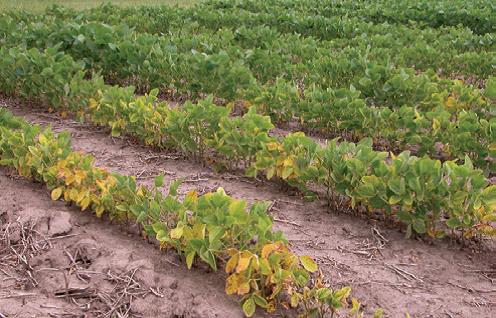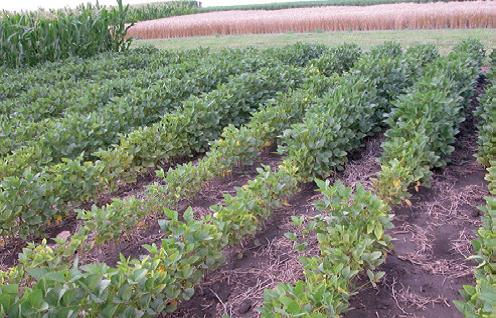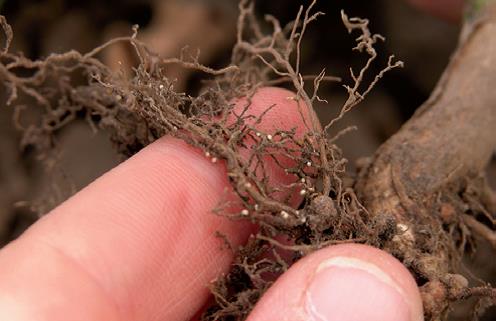
Soybean cyst nematode
| Primefact number | Edition | Published | Author |
|---|---|---|---|
| 1497 | First | Aug 2017 | Plant Biosecurity and Product Integrity |



Soybean cyst nematode (Heterodera glycines) is an exotic plant pest not present in Australia. This nematode is a serious threat to Australia’s pulse industry.
Soybean cyst nematode (Heterodera glycines) is a plant-parasitic nematode considered the world’s worst pest of soybeans. Young soybean cyst nematodes infest the roots of soybean crops while the adult female nematodes become egg filled cysts.
Notifiable status
Soybean cyst nematode (Heterodera glycines) is not a notifiable plant pest in NSW.
However, if you suspect soybean cyst nematode (Heterodera glycines):
- Call the Exotic Plant Pest Hotline 1800 084 881
- Email biosecurity@dpi.nsw.gov.au with a clear photo and your contact details
A full list of notifiable plant pests and diseases can be found in Schedule 2 of the NSW Biosecurity Act 2015.
Description
Soybean cyst nematodes are small worms which live on plant roots. Female nematodes look like small white or yellow lemon-shaped balls sticking out of the root. These pinhead-sized balls are about 1 mm wide. Male nematodes are hard-to-see tiny, threadlike, transparent worms.
Yellowing or stunting of soybean crops is an early symptom of soybean cyst nematode infestation (Figure 1). Poor canopy closure, plant dieback, early plant death and smaller seed size are other above-ground signs of these pests (Figure 2).
Soybean cyst nematodes cause dark coloured, poorly developed roots or severe root growth distortion. Infestations may be confirmed by sighting white or yellow female nematodes or brown cysts on the roots. Female nematodes or nematode cysts are smaller than the Rhizobium nodules on the soybean roots (Figure 3).
Patches of stunted plants can appear in the soybean crop. These patches are often spread in the direction of tillage as the cysts are moved through the soil by farm machinery.
Damage
Soybean cyst nematode crop losses range from 30% in fertile soils to total crop failure under low rainfall conditions.
The soybean cyst nematodes damage the plant roots and reduce root nodulation, causing nutrient deficiency symptoms which require extra fertiliser to curb yield losses.
When looking for this pest care needs to be taken as soybean cyst nematode damage can appear similar to the effects of drought stress, nutrient deficiency or herbicide damage.
Lifecycle
Soybean cyst nematodes can complete seven lifecycles in a cropping season and each female nematode lays up to 600 eggs.
The soybean cyst nematodes have three lifecycle stages: eggs, juveniles and adults. Juvenile nematodes emerge from the eggs after rainfall. The juvenile females invade the host plant root tips and establish feeding sites.
As they grow the female nematodes swell up with eggs and rupture the plant roots. When the adult female nematodes die their egg-filled bodies harden and become nematode cysts, which change colour from yellow to brown.
As the egg-filled nematode cysts are resistant to dehydration, the eggs inside them can remain viable for up to 11 years.
Host range
The main host plant of soybean cyst nematodes is soybeans. Minor hosts include adzuki bean, common bean, cowpea, common vetch, field pea, hairy vetch, lupins, mung bean and pigeon pea. Beetroot, deadnettle and tomatoes can also be infested by soybean cyst nematodes.
Spread
Soybean cyst nematodes are spread from farm-to-farm in cyst infested soil or plant material by farm machinery, footwear, humans, livestock, vehicles, water and wind. Juvenile nematodes can move through the soil from their eggs to host plants.
Distribution
Soybean cyst nematodes are found in most soybean growing countries and are present in Argentina, Brazil, Canada, China, Colombia, Egypt, India, Indonesia, Iran, Italy, Japan, Korea, Paraguay, Russia, United Kingdom and the United States of America.
Actions to minimise risks
Put in place biosecurity best practice actions to prevent entry, establishment and spread of pests and diseases:
- practice “Come clean, Go clean”
- ensure all staff and visitors are instructed in and adhere to your business management hygiene requirements
- source seed of a known high health status from reputable suppliers
- monitor your crops regularly
- keep records

